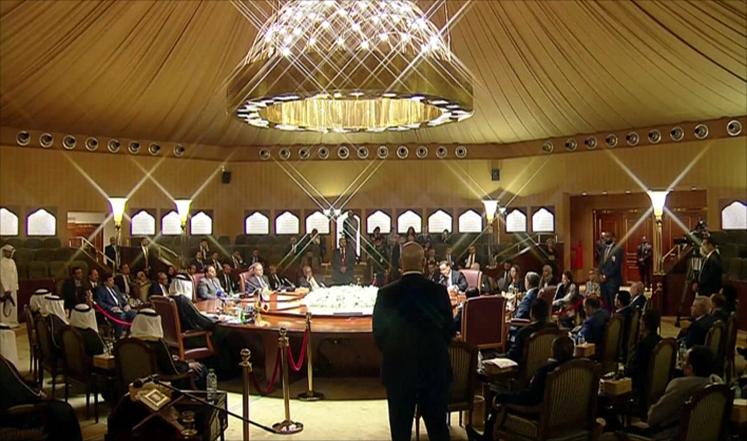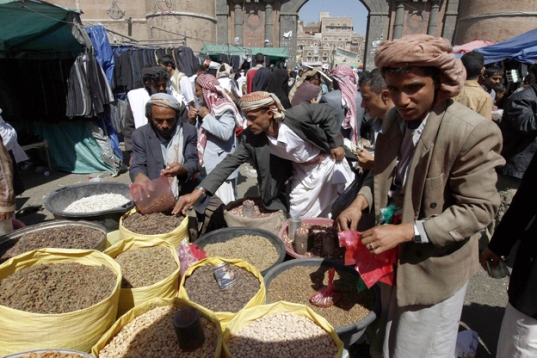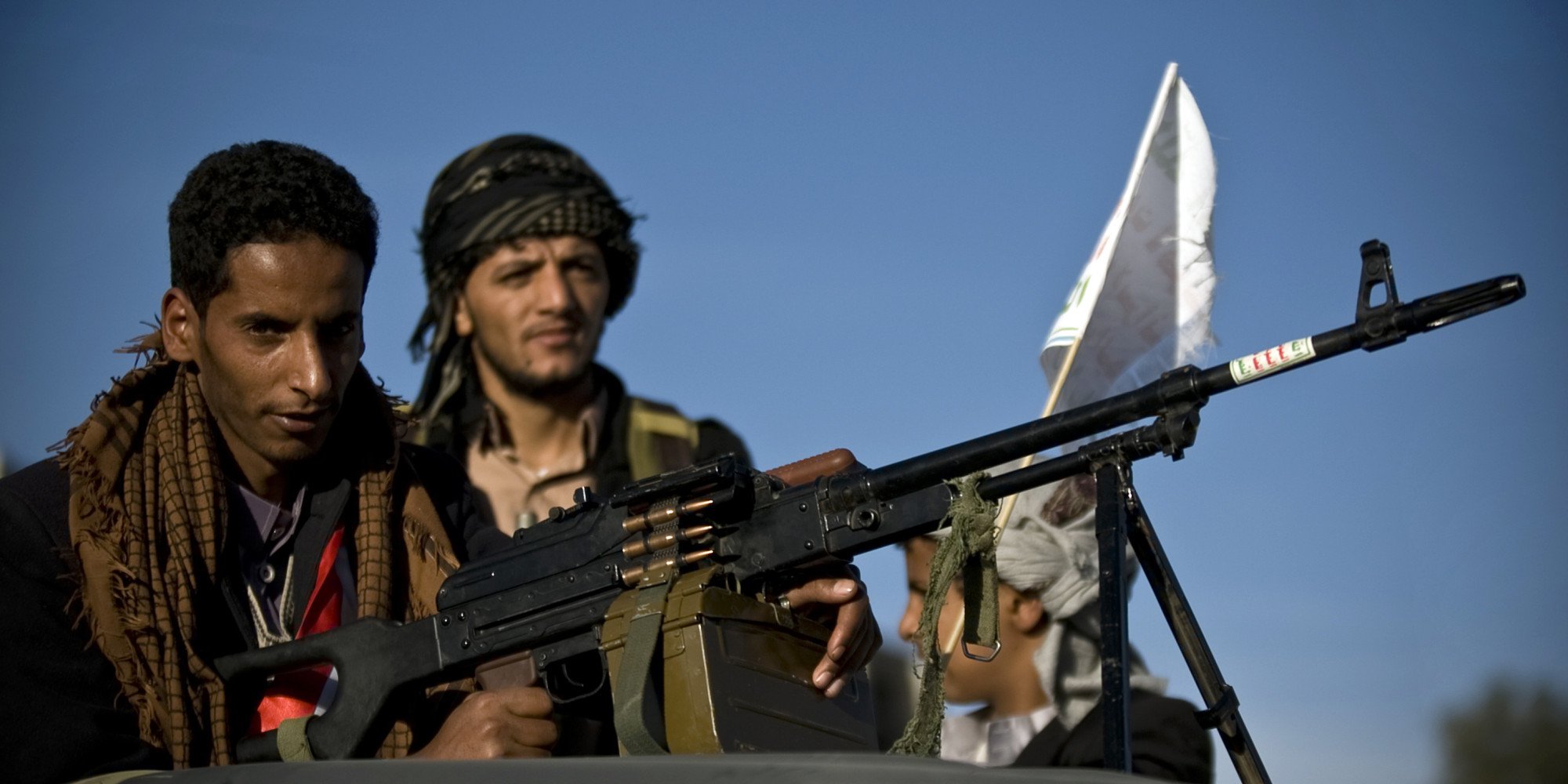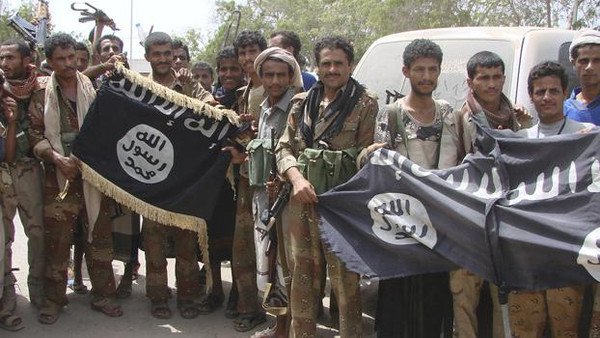In the first two chapters (1-3 ) ( 2-3 ), we discussed conditions in Iraq and Syria after the Iranian intervention that created neither “a new Iraq” nor “a new Syria”. Instead, they have become battlegrounds for sectarian conflicts and safe shelters for terrorist groups such as the ISIS and Al-Qaida. In light of their strategic locations and ideological trends, Iran doesn’t seem is going to miss any opportunity in these two countries.
In this chapter we’ll handle conditions in Yemen after the Iranian intervention in its affairs, and if it is still happy? Yemen is now torn out just like Syria, Iraq, and all other countries under the Iranian sphere of influence. What future is waiting for Yemen, and where is this country going? Yemeni people are suffering an ongoing conflict since 2015 between two factions claiming to constitute the Yemeni government, along with their supporters and allies. Houthi forces controlling the capital Sana’a and allied with forces loyal to the former president Ali Abdullah Saleh, supported by Iran, have clashed with forces loyal to the government of Abd Rabbuh Mansur Hadi, based in Aden and supported by the Arab Coalition. Al-Qaeda in the Arabian Peninsula (AQAP) and the Islamic State of Iraq and the Levant have also carried out attacks, with AQAP controlling swaths of territory in the hinterlands, and long stretches of the coast. In light of the latest developments, both sides of the conflict have not come to an agreement after negotiations on 15-07-2016.
At the beginning, Iran has recognized that the region is experiencing a state of political vacuum and prepared to fill it up through interference in the affairs of those countries since the eruption of the Arab spring in 2011. It also exploited the US invasion of Iraq in2003 and enhanced its expansion regardless all ethics and values of the good neighborhood. And now, Iran considers Yemen an important part of its Shiite Crescent.
Based on that, the Iranian interference in the affairs of other countries resulted from internal and external reasons. First of all, Iran has been trying to export the revolution since its eruption. This is related to the structure of the regime itself. It has adopted a policy of exporting problems just to divert the attention of its people to outsider crises, claiming the confrontation of tyrannical and evil forces of the world. The external reasons are related to its role as a major player in the region. Through the exportation of its ideology, Iran is trying to establish its Shiite empire throughout the Middle East. The ultimate goal of the Iranians in Yemen is to control the Red Sea chokepoint of Bab-el-Mandeb. This is a strategic chokepoint that could be used by Iran to block oil shipments and U.S. warship movements from the Mediterranean through the Suez Canal to the Indian Ocean and Arab Gulf. Iran has already been in control of the region’s other strategic chokepoint, the Strait of Hormuz in the Arab Gulf. Control over Bab-el-Mandeb would give Tehran additional regional power to control oil and other passage to and from the region. Iran seizes this opportunity, by supporting Houthis, to challenge the Arab Gulf countries especially Saudi Arabia, making them look more vulnerable, all while Tehran is showing off its regional significance to the Arab World and how it can cause a security threat to Riyadh, the pillar of the Arab Gulf unity and the major rival of the Iranian regional ambitions. The Iranian support to Houthis to take control of Sana’a was faced by the Saudi Arabia military intervention through the Decisive Storm.
The Yemeni geostrategic location also provides Iran with the opportunity to export its ideology to Africa since Yemen is a neighboring country to the African Horn countries, Eritrea, Djibouti, and Somalia. This is evident in the Iranian strategy through the many studies that reveal the Iranian presence in Africa because of its geostrategic location to Iran, and the mutual visits of Iranian and African officials to exchange ideas and enhance their relations on all levels.
The Iranian interference in Yemen has no more been a secret or a classified issue inside political and security agencies. It is now known to the public and on highest levels. Since his succession to the throne in February 2012, President Abdulhadi Abidraboh asked Iran to stop its interference in the Yemeni affairs for more than eight times. The latest one was on 10-7-2016. Houthis receive weapons and military training from Iran even before and after the rebellion in 2011. A shipment coming from Eritrea was intercepted on 11-7-2016. Iran also supported Houthis in their six wars against former president Saleh from 2004-2009. This support has continued through the attempts to overthrow the legitimate government in Yemen in 2014 and the Houthis capture of Sana’a. The Iranian representative “Ali Riza Zakani” has declared that Sana’a is the fourth Iranian capital of the Khomeini’s revolutionary expansion. As a result, Saudi Arabia responded to the official request of the legitimate president of Yemen after leaving the country in March 2015 to interfere and save Yemen from the Houthi-Iranian hostility. Indeed, this coalition launched military operations by using airstrikes to restore the former Yemeni government and hinder the Houthis advance toward Hadi’s stronghold in southern Yemen. Under the leadership of Saudi Arabia, 70% of the Yemeni lands have been liberated from Houthis. The big question that arises here is about the American-Iranian coordination on Yemen because of the quick and easy takeover of Sana’a by Houthis.
In order to maintain positions of its allies, Iran escalated the sectarian conflicts in northern Yemen by providing funding and weapons to the Zaydi-Shiite Houthi rebels. It also fueled unrest in the south and stirred up sedition between the south and the north through ethnicity and military uprising, and finally, the chaotic and lawless country at which Iran can reshape the balance of powers. Based on that, Iran has financed about twenty means of media since the beginning of the Yemeni rebellion. It also sought to license another seven newspapers and ten websites that work within one framework and plan. Iran also supported three satellite channels directed to the Yemeni people under the supervision of the Lebanese Almanar, the Iranian Alalam, and a third Iraqi channel. In addition to that, Iran has succeeded to attract political, parliamentary, and social prominent figures that are called “the external custody movement”, who visited Tehran and held meetings with political and religious leaders of Iran.
In order to implement its plans in Yemen, Iran has also involved the “Southern Uprising”. Head of the preparatory committee for the national convention for the Sons of the South, Mohammed Ahmed revealed that most uprising movements’ leaders have visited Tehran to get support and directives concerning the Iranian expansion in Yemen. He stressed that the Iranian interference is not only limited to Houthis in the north but also extended to the south. Iran has offered those leaders to train 6500 young fighters and deploy them in the southern part of Yemen. On the other hand, it has made alliances with ISIS and Al-Qaida in Yemen. The evidence for the relationship between Iran and Al-Qaida is the letter of appreciation from Al-Qaida leader Aiman Al Zawahiri stating, “Without the assistance of Iran, we couldn’t have launched the attacks on the US embassy in Sana’a on 13-9-2012”. Based on that, there is a close relationship between the focus of Al-Qaida on Yemen and the active Iranian presence in this country. Yemen has become a major strategic installation for Al-Qaida and a fruitful area for enlistment. The Iranian Revolutionary Guards had a big hand in making Yemen a major mobilization center for the ISIS and Al-Qaida operations.
Consequently, the Iranian interference has led to a “Mourning Yemen” on all levels. The situation is disastrous. It is standing at the threshold of failure and breakdown, and nonstop conflicts especially in light of the failure of the international and regional peace efforts between the two sides of the crisis, which resulted in:
 1-Negotiations Breakdown: The Decisive Storm and Security Council resolution 2216 were a turning point in the Yemeni conflict. Negotiations launched between Houthis and former president Saleh, proxies of Iran on one side, and President Hadi Abdrabouh on the other side in Kuwait, april2016. Negotiations lasted until July 2016 without coming up to an agreement because of the Iranian implementations on its agents when they required the so-called “the deterring one-third power” in the parliament on the model of the Lebanese Hezbollah.
1-Negotiations Breakdown: The Decisive Storm and Security Council resolution 2216 were a turning point in the Yemeni conflict. Negotiations launched between Houthis and former president Saleh, proxies of Iran on one side, and President Hadi Abdrabouh on the other side in Kuwait, april2016. Negotiations lasted until July 2016 without coming up to an agreement because of the Iranian implementations on its agents when they required the so-called “the deterring one-third power” in the parliament on the model of the Lebanese Hezbollah.
The United Nations delegate Ismael Weld Alsheikh on 10-7-2016 referred to the big gap in negotiations that focused on the withdrawal of the armed militias, handing over heavy and medium guns to the governmental organizations, resuming comprehensive political talks, and establishing a committee for prisoners. Houthis rejected those terms, supported by Iran. They called for the establishment of a national unity government including them. This was their condition to end fighting which was rejected by the government, especially after the Arab group and a number of African nations had succeeded in aborting a resolution on 11-7-2016 in the Security Council that supports the establishment of a national unity government including Houthis in Yemen and the “deterrence one-third”
2-Difficult economic conditions:
 Houthis took control of the Yemeni central bank. The Yemeni happiness has been vanished at the war in 2014. The daily living and basic needs have become a burden to most Yemeni people as a result of high unemployment and poverty. The purchasing power of Rial has deteriorated against Dollar. The lack of cash flow and a decrease in revenues up to 53% in 2016. In June 2016 food and agriculture world organization (FAW) declared that 14.4 million out of 26 million Yemenis suffer food shortage. 70% of people can barely earn their daily food and nutrition. On 7-7-2016 the social progression indicator, in its classification of the year 2016 showed that Yemen occupies the 7th rank on the list of the worst living conditions in the world.
Houthis took control of the Yemeni central bank. The Yemeni happiness has been vanished at the war in 2014. The daily living and basic needs have become a burden to most Yemeni people as a result of high unemployment and poverty. The purchasing power of Rial has deteriorated against Dollar. The lack of cash flow and a decrease in revenues up to 53% in 2016. In June 2016 food and agriculture world organization (FAW) declared that 14.4 million out of 26 million Yemenis suffer food shortage. 70% of people can barely earn their daily food and nutrition. On 7-7-2016 the social progression indicator, in its classification of the year 2016 showed that Yemen occupies the 7th rank on the list of the worst living conditions in the world.
3-Disastrous security conditions:
 Yemen is witnessing a state of chaos and lawlessness since 2011. War erupted a year ago between the governmental forces supported by the Arab coalition forces and insurgents supported by Iran. This war doesn’t seem to come to an end. The common slogan in Yemen has become, “I fight, I Survive”
Yemen is witnessing a state of chaos and lawlessness since 2011. War erupted a year ago between the governmental forces supported by the Arab coalition forces and insurgents supported by Iran. This war doesn’t seem to come to an end. The common slogan in Yemen has become, “I fight, I Survive”
4-Widespread corruption: Yemen is witnessing an unprecedented state of corruption that has never witnessed for decades. Offenses committed against public property and governmental lands. Even humanitarian aids couldn’t escape corruption. Yemen has occupied rank 154th out of 168 countries according to statistics from the International Transparency Organization. In light of the current circumstances, growing the population to more than 26 million, lack of natural resources, high unemployment, and the absence of investors and donors, corruption has become a serious threat to the present and future of the country and its people.
5-Al-Qaida and ISIS:
 Both organizations appeared after the killing of Amir of Al-Qaida in the Arab peninsula Nasir Alwheishi in June 2015 by an unmanned airplane and succeeded by Qasem Alreemi, a supporter of the inauguration of Albaghdadi. In light of that, Al- Qaeda presence has deteriorated in favor of the ISIS that is now adopting every qualitative terrorist operation with the absence of all political and media activities of Al-Qaida in Yemen. It seems that the ISIS is dominating the scene with its devastating and qualitative operations, especially in Aden. It is estimated that ISIS has committed 33 assassinations and four car bombs explosions resulted in 34 killed and 43 wounded only in January 2016 in Aden. This situation has incurred a big impact on the security of the Arab Gulf countries in two terms; the first is the threats to the national security of these countries through the sectarian conflicts in Yemen and the fear of exporting these conflicts to these countries. Houthis hostility has proved the exposure of the Gulf security to dangers through their mobilization into the inside of Saudi territories, which resulted in the Decisive Storm to defend the Saudi lands, and stop drugs and weapons smuggling from Yemen due to lawlessness and chaotic situation. The second one is the consequences of the Iranian intervention and its attempt to deter the Gulf countries unity through creating obstacles in this way. Iran sees the Gulf countries’ unity a threat to its ambitions in the region and rejects dealing with this council as one entity. Iran is doing its best to hinder any activity that enhances security, and political and economic position of the Gulf countries just like the thwart of the Gulf initiative in Yemen. Based on that, there are many scenarios for the future of Yemen in case negotiations that have been running since 15-7-2006 in Kuwait fail. The first possibility is the resumption of fighting and partial resumption of the Decisive Storm with training the Yemeni forces to take Sana’a back from Houthis. This scenario is costly, which makes it weak. The other one is Lessing tension and continuation of negotiations, which suggests that the Yemeni crisis could end up in a truce through the United Nations delegate exerting pressure on both sides of the conflict, which is also a weak scenario because it relies on the seriousness and willingness of the two parties. The third one is the failure of negotiations and deviating to the Somali model. This also relies on the escalation between the two parties because of not fulfilling each side’s demands and goals, which lead to instability and chaos that ends up in the civil war. This is the most probable scenario because of the Iranian sectarian support. The fourth and the most serious scenario is division. Houthis and Iran might adopt this scenario in case they fail to dominate the future of Yemen and achieve what they have sought. This one seems to be improbable because of the continuation of the Arab support to president Hadi against the internal ambitions of Houthis. Although, this scenario is progressing steadily in light of the absence of a satisfactory solution for all sides despite the resumption of negotiations on 15-07-2016 in addition to the Iranian dictation to Houthis and Saleh to not compromise, stick to their demands of the deterring one-third power, and rejecting the handover of their weapons.
Both organizations appeared after the killing of Amir of Al-Qaida in the Arab peninsula Nasir Alwheishi in June 2015 by an unmanned airplane and succeeded by Qasem Alreemi, a supporter of the inauguration of Albaghdadi. In light of that, Al- Qaeda presence has deteriorated in favor of the ISIS that is now adopting every qualitative terrorist operation with the absence of all political and media activities of Al-Qaida in Yemen. It seems that the ISIS is dominating the scene with its devastating and qualitative operations, especially in Aden. It is estimated that ISIS has committed 33 assassinations and four car bombs explosions resulted in 34 killed and 43 wounded only in January 2016 in Aden. This situation has incurred a big impact on the security of the Arab Gulf countries in two terms; the first is the threats to the national security of these countries through the sectarian conflicts in Yemen and the fear of exporting these conflicts to these countries. Houthis hostility has proved the exposure of the Gulf security to dangers through their mobilization into the inside of Saudi territories, which resulted in the Decisive Storm to defend the Saudi lands, and stop drugs and weapons smuggling from Yemen due to lawlessness and chaotic situation. The second one is the consequences of the Iranian intervention and its attempt to deter the Gulf countries unity through creating obstacles in this way. Iran sees the Gulf countries’ unity a threat to its ambitions in the region and rejects dealing with this council as one entity. Iran is doing its best to hinder any activity that enhances security, and political and economic position of the Gulf countries just like the thwart of the Gulf initiative in Yemen. Based on that, there are many scenarios for the future of Yemen in case negotiations that have been running since 15-7-2006 in Kuwait fail. The first possibility is the resumption of fighting and partial resumption of the Decisive Storm with training the Yemeni forces to take Sana’a back from Houthis. This scenario is costly, which makes it weak. The other one is Lessing tension and continuation of negotiations, which suggests that the Yemeni crisis could end up in a truce through the United Nations delegate exerting pressure on both sides of the conflict, which is also a weak scenario because it relies on the seriousness and willingness of the two parties. The third one is the failure of negotiations and deviating to the Somali model. This also relies on the escalation between the two parties because of not fulfilling each side’s demands and goals, which lead to instability and chaos that ends up in the civil war. This is the most probable scenario because of the Iranian sectarian support. The fourth and the most serious scenario is division. Houthis and Iran might adopt this scenario in case they fail to dominate the future of Yemen and achieve what they have sought. This one seems to be improbable because of the continuation of the Arab support to president Hadi against the internal ambitions of Houthis. Although, this scenario is progressing steadily in light of the absence of a satisfactory solution for all sides despite the resumption of negotiations on 15-07-2016 in addition to the Iranian dictation to Houthis and Saleh to not compromise, stick to their demands of the deterring one-third power, and rejecting the handover of their weapons.
Finally, the Yemeni experience has proved that violent change of power of Saleh, who has turned against his country and hooked up with Houthis that had long fought against him, is worth studying and analyzing. Saleh is the president that has been partially toppled. His military and security forces are still standing which has made him an active player in the Yemeni crisis. This gives a lesson to all people of the region, especially Syrians. In order to take Assad down, his military and security forces must be broken down to a point of no return. Otherwise, the situation would turn into a worse and more complicated one than that of Yemen.
